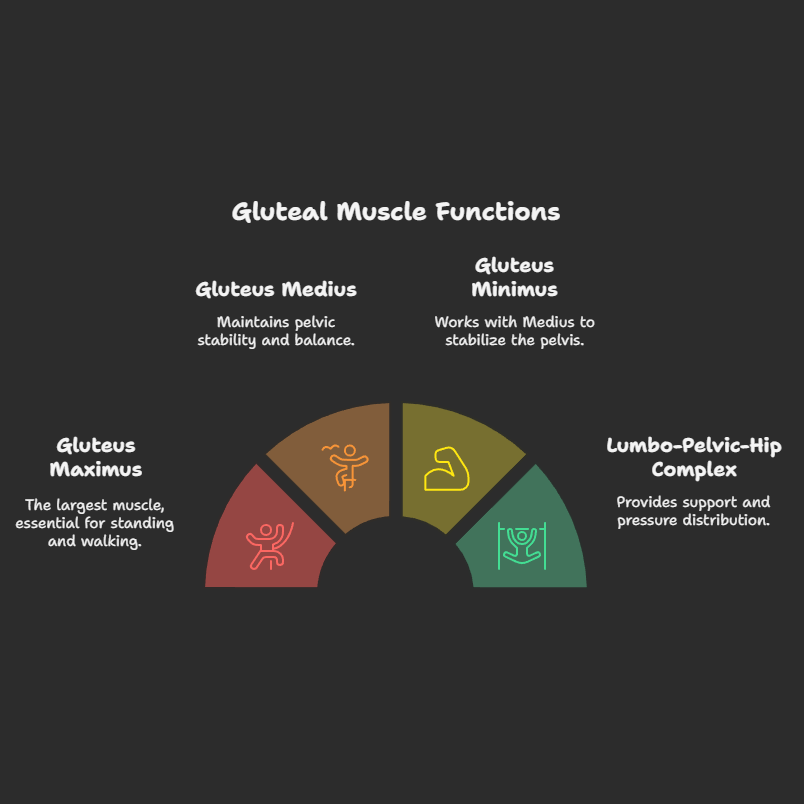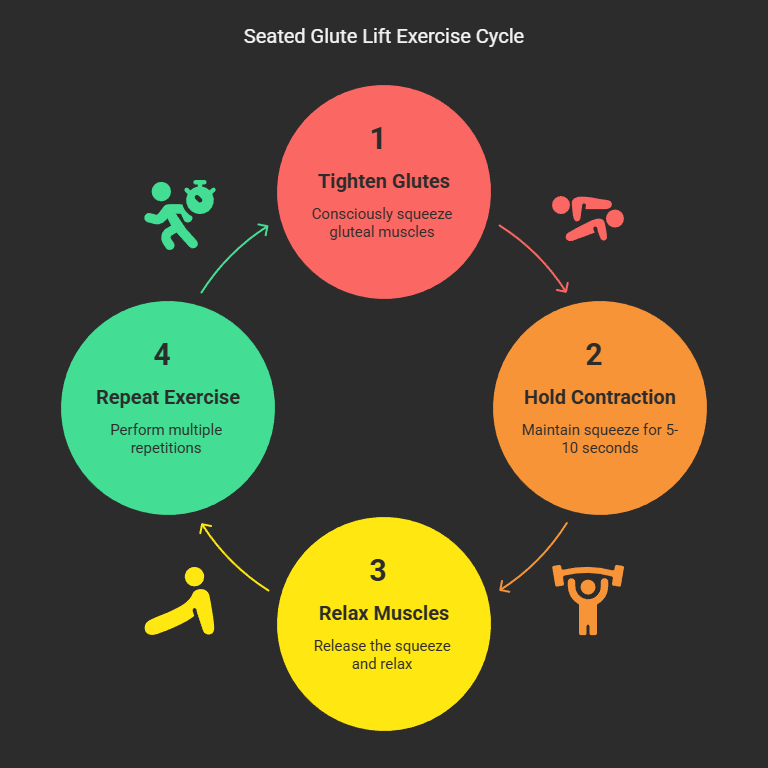Do you often experience lower back pain, numb or weak glutes, or even an overall feeling of stiffness after spending long hours at your office desk, on the sofa, or during your commute? This is an almost universal picture of modern sedentary life.As an experienced massage therapist, I encounter clients every day who suffer from issues caused by prolonged sitting. This discomfort doesn't just impact your quality of life; it might also be silently undermining your health.However, change often starts small. Today, I want to share with you an extremely simple yet surprisingly powerful movement – the "Seated Glute Lift Exercise." It will be your first step in combating the discomforts of sitting and moving towards a "Happy Healthy Life."
Your Glutes: More Than Just a 'Seat Cushion'!
Many people might mistakenly believe that the main function of the buttocks is simply to provide a comfortable seat. However, from a biomechanical standpoint, the role of the gluteal muscles (or "glutes") is far more important and complex than that of a "natural seat cushion."The glutes are primarily composed of three muscles: the **Gluteus Maximus**, **Gluteus Medius**, and **Gluteus Minimus**.* The **Gluteus Maximus** is one of the largest and most powerful muscles in the human body, responsible for movements like standing and walking. * The **Gluteus Medius** and **Minimus** are vital for maintaining pelvic stability.Together, these muscles form the core of the "Lumbo-Pelvic-Hip Complex" (腰盆髖複合體), offering stable support to our trunk and effectively helping to distribute pressure away from the lumbar spine. When your glutes are strong and active, they act to protect your spine. Conversely, when they become weak, the lower back and hamstring muscles often tighten up to compensate ($dàicháng$ - 代償), which can set off a chain reaction of discomfort and problems.

"Gluteal Amnesia": When Your Glutes Forget How to Work
Have you ever stood up after sitting for a long time and felt as though your glutes "aren't quite your own"? This could be a phenomenon known as "Gluteal Amnesia."This doesn't mean the muscles are actually damaged. Rather, due to prolonged sitting and a lack of activity, their activation levels decrease – it's as if they've "forgotten" how to function. When we sit, our glutes are held in a lengthened, relaxed state, while our hip flexors become short and tight. This imbalance inhibits the glutes' ability to activate. In fact, research suggests that just 30 minutes of continuous sitting can cause the glutes to "go dormant" or "fall asleep."This doesn't just affect your posture; it can lead to issues like anterior pelvic tilt, lower back pain, and can even have knock-on effects on your knees and ankles. In my clinical experience, the root cause of many cases of lower back pain can actually be traced back to these "amnesic" or underactive glutes.
The Seated Glute Lift Exercise: A Simple Way to Awaken Your Glutes
Now, let's focus on the core element – the "Seated Glute Lift Exercise."Its essence is simple: While sitting, consciously tighten (squeeze) your gluteal muscles, hold the contraction for 5 to 10 seconds, then relax. Repeat this multiple times.This is an "Isometric Contraction" ($děng cháng shōusuō$ - 等長收縮), an ideal exercise for reawakening muscles and rebuilding that vital mind-muscle connection. Its biggest advantage is its unparalleled convenience. It requires no equipment and can be done anywhere – you can practice it anytime in the office, at home, or even during your commute.I often recommend this to my clients, particularly office workers ($shàngbān zú$ - 上班族), as it transforms "sitting time" – which usually exacerbates issues – into a chance to improve health. It empowers you to proactively "reclaim" control over your body.

Unveiling the Benefits: Why is This "Simple Squeeze" So Amazing?
The benefits of the Seated Glute Lift Exercise are multifaceted:1. **Awakens Glutes & Improves Mind-Muscle Connection:** It effectively awakens dormant gluteal muscles and strengthens the "mind-muscle connection" ($xīnlíng yǔ jīròu de liánjié$ - 心靈與肌肉的連結). This helps your brain "re-remember" how to activate these muscles, effectively combating Gluteal Amnesia. 2. **Enhances Stability:** It strengthens the stability of both the pelvis and the lumbar spine. When you squeeze your glutes, you create a solid support platform for your spine. It also helps to tension the "Thoracolumbar Fascia" ($xiōng yāo jīnmó$ - 胸腰筋膜) – a key structure in your back – essentially providing your lower back with a natural 'stability belt'. 3. **Improves Alignment & Reduces Pain:** It aids in maintaining proper pelvic alignment, which helps counteract anterior pelvic tilt and, consequently, alleviate lower back pain. 4. **Boosts Body Awareness:** Lastly, this simple exercise boosts your body awareness ($shēntǐ juéchá nénglì$ - 身體覺察能力). This makes it easier for you to identify and correct poor sitting habits, fostering healthier posture overall.

Precise Execution: Performing the Seated Glute Lift Correctly
To achieve the maximum benefits, performing the exercise correctly is essential. Here’s how:1. **Setup:** Sit on the front edge of a stable chair. Place your feet flat on the floor with your knees bent at a 90-degree angle. Maintain a neutral spine (keep it naturally straight without arching or slumping). 2. **Focus:** Concentrate your attention on your glutes (buttocks muscles). 3. **Squeeze:** Consciously squeeze both gluteal muscles together. Imagine you are using their strength to *slightly* lift yourself off the chair (though you don't actually need to lift off). Ensure you feel the contraction deep within your glutes, rather than relying on your thighs or lower back. 4. **Hold & Breathe:** Hold this contraction for 5 to 10 seconds. It is crucial to continue breathing naturally throughout this hold – **do not hold your breath**. 5. **Relax:** Completely relax your glutes and notice the sensation as the muscles release. 6. **Repeat:** Repeat this process 10 to 15 times to complete one set. It's recommended to aim for one set every hour.**Pro-Tip:** You can place your hands on your glutes as you perform the exercise. This allows you to feel the muscles tense and harden, helping you confirm that you're engaging the right ones.
Common Pitfalls: Avoid These Mistakes to Maximize Results
Even with simple exercises, incorrect execution can diminish their effectiveness. Here are some common mistakes to avoid:1. **Holding Your Breath ($biē qì$ - 憋氣):** This is the most frequent error. It increases unnecessary tension and pressure. Always remember to maintain natural, steady breathing throughout the exercise. 2. **Arching Your Back or Wobbling Your Pelvis:** This shifts the stress onto your lumbar spine instead of working the intended muscles. Focus on keeping your spine in a neutral position and ensure the movement is initiated and controlled solely by your glutes. 3. **Compensating with Hamstrings or Back Muscles:** Avoid relying on your hamstrings or back to do the work. If you feel these areas straining more than your glutes, stop, readjust your position, and try again, perhaps starting with a gentler contraction to isolate the glutes. 4. **Tensing Your Shoulders, Neck, or Jaw:** Be mindful to keep your upper body relaxed. The effort should be concentrated purely in your glutes. 5. **Incomplete Contraction or Relaxation:** To achieve the best results, ensure each squeeze is full and strong, and, just as importantly, allow your glutes to relax *completely* between each repetition.
Taking It Further: Simple Variations and Progressions
Once you feel comfortable and proficient ($déxīnyìngshǒu$ - 得心應手) with the basic movement, you can try some variations to keep challenging your glutes:* **Increase Contraction Intensity:** Try squeezing with more force and intent. * **Extend the Hold Time:** Gradually work on holding the contraction for longer, aiming for more than 10 seconds. * **Alternating Single-Side Squeezes ($dānbiān jiāotì shōusuō$ - 單邊交替收縮):** Challenge yourself by contracting only your left glute, then only your right. This is excellent for addressing any left-right imbalances.Furthermore, you can extend this activation principle to other moments in your day – for example, perform "Standing Glute Squeezes" ($zhàn zī tí tún$ - 站姿提臀) while waiting in line or brushing your teeth.If you're looking for more advanced exercises to do at home, the "Glute Bridge" ($tún qiáo$ - 臀橋) is an excellent addition. It works your glutes through a greater range of motion; just remember to concentrate on a powerful glute contraction at the top (peak) of the bridge.
Listen to Your Body: Important Precautions
Although the Seated Glute Lift Exercise is safe and beneficial for most people, it's crucial to learn how to listen to your body.**Stop Immediately If:*** You experience any sharp, increasing, or radiating pain during the exercise.**Avoid or Consult a Professional First If:*** You are currently dealing with "acute, severe lower back pain" ($jíxìng, yánzhòng de xià bèi tòng$ - 急性、嚴重的下背痛) or have diagnosed disc issues (especially during an acute phase). * You have "Pelvic Floor Dysfunction" ($gǔpén dǐ gōngnéng zhàng'ài$ - 骨盆底功能障礙), particularly the hypertonic (overly tense) type. * You have "known hip joint pathologies" ($yǐ zhī kuān guānjié bìngbiàn$ - 已知髖關節病變), such as FAI (Femoroacetabular Impingement).In these specific conditions, the seated position or the act of contraction could potentially worsen symptoms, so modification or avoidance might be necessary.**My firm advice is: If you have *any* doubts or concerns, it is essential to consult your doctor, physical therapist, or massage therapist before proceeding.**
Making It a Habit: A Massage Therapist's Tips for Daily Integration
To ensure the Seated Glute Lift Exercise is truly effective, the key lies in integrating it seamlessly into your daily life. Here are some techniques:* **Link to Existing Habits:** Try doing a few reps every time you sit down, or perhaps after replying to an important email. * **Set Reminders:** Use your phone or calendar to set hourly or periodic reminders. * **"Exercise Snacking" ($yùndòng língshí$ - 運動零食):** Think of it as a brief "snack" to break up long periods of sitting. Aim for "little and often" rather than one long session.From my perspective as a massage therapist, adopting this habit brings several benefits:* **Maintains Treatment Efficacy ($wéichí liáoxiào$ - 維持療效):** It helps to extend the benefits and relaxation you feel after a massage session. * **Enhances Body Awareness:** It improves your connection with your body, meaning you can provide more precise feedback during your therapy sessions. * **Promotes Partnership:** Most importantly, it empowers you to "actively participate" ($zhǔdòng cānyù$ - 主動參與) in your own health journey. This creates a "teamwork" ($tuánduì hézuò$ - 團隊合作) dynamic with your therapist, allowing us to work together to break free from unhelpful muscle compensation patterns.
Conclusion: The Power of 'One Squeeze' – Stepping Towards a Healthier You!
In summary, the Seated Glute Lift Exercise is a simple yet powerful tool to effectively combat the negative impacts of prolonged sitting. It serves as a reminder that even in seemingly ordinary moments, we can make active, positive changes for our health.Through regular practice, you can reawaken your glutes, enhance your core stability, improve your posture, and keep lower back pain at bay.Don't let long hours of sitting lull your glutes to sleep. Starting today, make an effort to perform several conscious glute squeezes throughout your day. Your body – particularly your back and glutes – will thank you for it, leading you towards a more comfortable and vibrant "Happy Healthy Life"!
